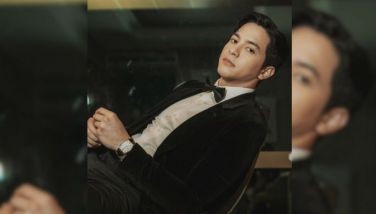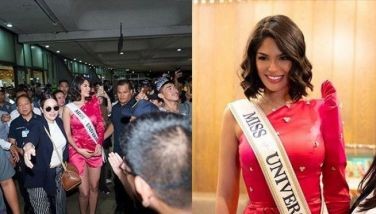The rare magnificence of Rachelle, Arthur, Andrew / Ching's Concerto da Camera
The following night, the Filipino cast took over the three major roles in ‘Traviata’: Rachelle Gerodias, arguably our most sought-after soprano, was the courtesan Violetta; La Scala tenor Arthur Espiritu, Alfredo, her lover; multi-awarded international baritone Andrew Fernando, Germont, Alfredo’s father.
A petite, pretty nightingale, a diva in the truest sense, Rachelle was at her best. She enthralled the audience, her strong, stirring voice inexplicably emanating from a tiny frame. In infinitely varying volumes, her voice lingered long in both soft and loud passages of the over-extended arias.
Her face expressed jubilation, wonder or annoyance as she moved about the stage gracefully, belying rather than flaunting her questionable trade, her feminine wiles thereby attracting Alfredo instantly. Her arias ‘Un di felice eterea’ (Rapturous moment) and ‘Sempre libera’ (I’ll fulfill the round of pleasure) were exuberantly rendered.
Impetuously falling for Violetta, Arthur as Alfredo sang with a luminous voice that reached the rafters with shattering power.
In his arias, his solid grasp of text and meaning, his clarity and striking brilliance made them eloquently persuasive to the highest degree.
Rachelle and Alfredo were a fascinating pair in their duets, sending the audience into “ecstatic” states as they sealed their rapturous love with a kiss, infusing a touch of reality into their romance.
In Act III, Andrew Fernando, appearing as the third principal character, Germont, revealed his commanding presence with a similarly commanding voice of unequalled force and fervor, creating tension, both vocal and dramatic, while pleading with Violetta to give up Alfredo to save the Germont name. In the aria ‘Imponete’ (Command me), Violetta was pitifully docile.
Andrew sent shivers down the spine as he delivered the daunting aria ‘Di Provenza il Mar’, invoking the charms of Provence as he cajoled Alfredo to return to their country home. How he infused his magnetic air with admirably smooth legatos and cantilenas!
In the final Act, Violetta, faint and trembling, while making a supreme effort to stand, dies in Alfredo’s arms while he crumbles in grief and despair. Here, the duo projected the ultimate in pathos.
Rachelle, Arthur and Andrew shared the highest praise as they enchanted the listeners with their arias, or their inter-action, each singing and emoting with rare magnificence. Individually and collectively, they remarkably pointed up Verdi’s genius in delineating human frailty and nobility, all three rising to the challenge presented by the exquisite, heart-wrenching music-drama of one of opera’s greatest tragedies.
For some unknown reason, the UST Singers were performing with greater cohesion, verve and spirit than they did with the Korean cast; take for instance, the Drinking Song, “Opening night jitters” was the explanation a member of the audience offered.
Once again, Korean conductor Jae-Joon Lee gave the score a most sensitive reading, the music by the PPO swelling or subsiding in each aria duet, trio or choral song. Under Floy Quintos’ direction, the opera throbbed with life throughout.
Jeffrey Ching’s Concerto
Instrumentation: Solo guitar (with plectrum and side bar, and discreetly amplified); Solo violoncello; Optional Solo Soprano (singing from within or behind the orchestra); String Orchestra: 5 First Violins, 5 Second Violins, 4 Violas, 3 Violoncellos, 2 Double Basses (with low C string).
Duration: I. Passacaglia a la sarabande — ca. 16 minutes. II. Fuga concertante — exactly 11 minutes 40.6 seconds. Total: ca. 30 minutes.
One could say that Jeffrey Ching’s Concerto da camera was written as a ‘quintuple concerto’ for the five nationalities of its original begetters: German for the guitarist Reinbert Evers; Lithuanian for his wife, the pianist Igina Mauzaite (although the concerto never included a piano part); Brazilian for the cellist Matias de Oliveira Pinto; the Spanish ancestry of the composer’s wife, the soprano Andion Fernandez; and the composer’s own Chinese parentage. Composed in Berlin between 2 March and 2 July 2008 and revised in 2010 and 2011, the concerto is about half an hour in duration, and divides into a slow and a quick movement, in each of which the five musical races combine in diverse ways:
The opening Passacaglia á la sarabande alternates three statements of a “V-I-L-N-I-U-S” motto (A-A-E-G-A-G-Eb) with three presentations of the Sarabande from J. S. Bach’s Fifth Suite for unaccompanied ‘cello (BWV 1011), each incorporating some figurative or abstract representation of a national element: sheng-type chords, quotations of zither music, and poetic fragments from medieval China; the rhythms and harmonies of Brazilian indigenous and popular music; the dissonant polyphony, nonsense syllables, and wide vocal glissandi of the Lithuanian sutartines; and in the optional soprano solo at the movement’s core, some Spanish lines from Cervantes’ Don Quixote — some in Edith Grossman’s translation: “Hear this melancholy maiden,/so wellborn and so ill-fated:/in the light of your two suns/she feels her soul burst into flames./O tell me, most valiant youth,/— may God make your wishes prosper —/if Libyan sands were your home,/or the craggy peaks of Jaca;/if you suckled a serpent’s milk or by chance you had for nurses/the harshness of the wild forest/and the horrors of the mountains”).
The concluding Fuga concertante exactly doubles the proportions of the finale of J. S. Bach’s Fourth Brandenburg Concerto (BWV 1049), as well literally doubling its contrapuntal premise into a double fugue on two Lithuanian folk songs. As in the Bach, the fugal ritornelli are interspersed with elaborate cadenzas for the instrumental soloists, in one place in the form of the actual tracing on the guitar and ‘cello fingerboards of the Chinese brushstrokes for the ideographs for ‘broken string’. During the fifth ritornello, the soprano’s first movement solo recurs in fragmentary guise as a wordless vocalise so that in this movement the Spanish as well as Chinese presence survives only in allusive form. On the other hand the Afro-Brazilian elements come into their own as a candomble ceremony in miniature, the ethno-musicologically documented drumming, cowbell, and clapping effects all mimicked by the string orchestra and solo guitar without any actual percussion. The concerto ends with the dense Baroque counterpoint of solo guitar and ‘cello unwinding into silence like a rundown motor, by means of well-coordinated coups de grace administered to the soloists’ tuning pegs by three players from the orchestra.
- Latest
- Trending




























